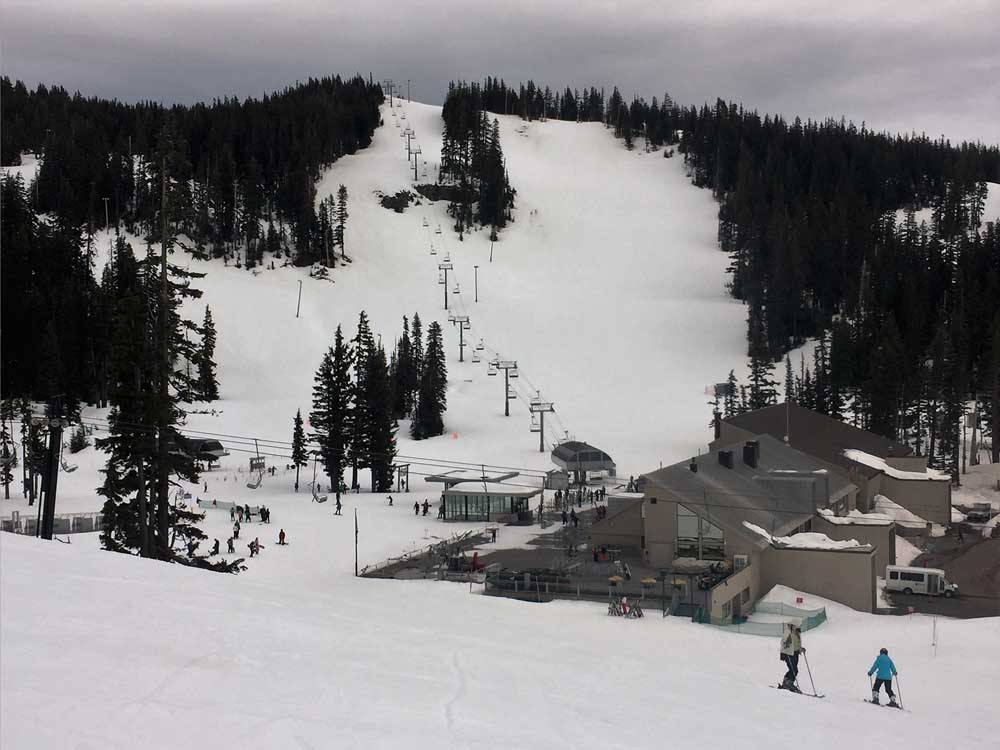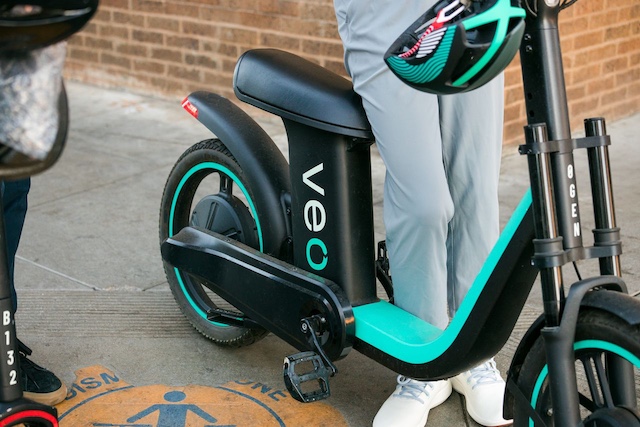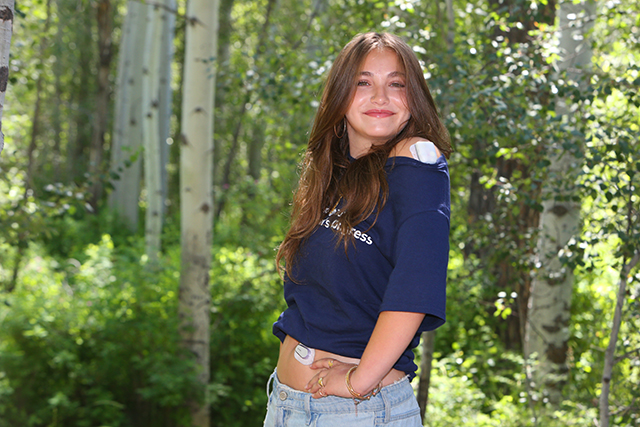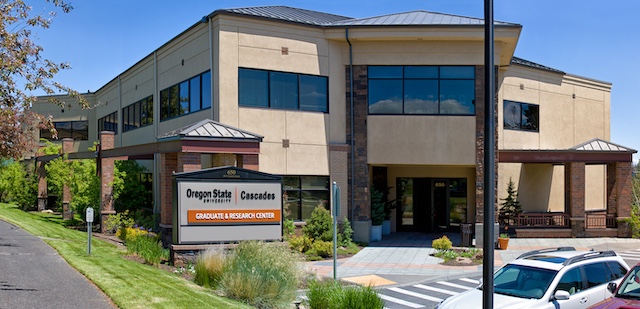Skiing the Cascades in Oregon, Washington and California
Published 11:56 pm Sunday, January 8, 2017

- The Stadium Express chair lift, built for the 2011-12 season, rises from the Mount Hood Meadows day lodge. The diverse terrain at Meadows ranges from easy novice slopes to expert chutes in the restricted-access Heather and Clark canyons.
Alpine skiing was introduced to the Pacific Northwest in the late 19th century, not too many decades after the modern sport emerged in Norway. It began to boom after luxurious Sun Valley, built in Idaho by the Union Pacific Railroad, installed the first chairlift (based on tropical banana hoists) in December 1936.
Downhill skiers in Oregon and Washington had previously faced strenuous workouts, both driving to the mountains on poorly maintained roads and climbing slopes with skins (or by herringbone or sidestepping techniques) for the short runs down.
Trending
That changed once rope tows were installed in 1937 in Washington at Snoqualmie Pass, Mount Baker and Mount Rainier’s Paradise Lodge, and the following winter at Oregon’s Timberline Lodge. Timberline added its Magic Mile chair in 1939; skiing at Bend’s Skyliners Lodge also began in the late ’30s.
It made sense that these ski areas were concentrated in the Cascade Range, the volcanic backbone of the Northwest. Extending from southern British Columbia into California, rising to more than 14,000 feet at Rainier and Mount Shasta, the lava domes offered gentle precipices to lure beginning and intermediate skiers, along with voluminous amounts of winter snow.
While other ski areas were developed around the region — Anthony Lakes in northeastern Oregon, for instance, along with Hurricane Ridge in Washington’s Olympics and several in eastern Washington and Idaho — the Cascades have retained their attraction, especially to skiers from the more populous Puget Sound and Willamette Valley regions.
Today there are 18 separate ski resorts in this mountain range, extending from Mount Baker, just south of the Canadian border, to lofty Mount Shasta in Northern California. Some of them are tiny: Loup Loup, in Washington’s Methow Valley, has two chairs; Cooper Spur, near Hood River, has one; the ski hill at Leavenworth, Washington, has only a pair of rope tows. Mount Bailey, overlooking Oregon’s Diamond Lake, is served only by a snowcat.
Other resorts, however, are quite large. Our own Mount Bachelor, along with Mount Hood Meadows and Washington’s Crystal Mountain, have 11 lifts, while Stevens Pass, northeast of Seattle, has 10. And the Summit at Snoqualmie boasts no fewer than 26 lifts at four integral hills, each one shuttle distance from the next.
Here’s where to ski in the Cascades this winter:
Trending
Oregon
Timberline: Completed in 1938 as a Works Progress Administration project during the Great Depression, historic Timberline Lodge — at 6,000 feet elevation on the south side of Mount Hood — became Oregon’s first destination ski resort with a single portable rope tow. A year later, the Magic Mile chairlift extended 1,000 vertical feet above the lodge; additional terrain opened on lower slopes in the 1950s. Since the Palmer chair was built in 1983 above 7,000 feet, Timberline is the only ski area in the U.S. with year-round lift-accessed skiing.
Timberline Ski Area. 27500 E. Timberline Road, Timberline Lodge; timberlinelodge.com, 503-272-3311. All-day adult tickets $68; open every day (nights Friday and Saturday). Summit 8,540 feet, vertical 3,690 feet, nine lifts.
Mount Hood Skibowl: The largest night-skiing area in the United States may suffer from low altitude — its base area, on U.S. Highway 26, sits at just 3,600 feet elevation — but it has the advantage of being the nearest area to Portland (56 miles) and having the only true slope-side village in the Northwest. About two-thirds of its 960 acres, served by four lifts, are lit for nightly skiing. The adjacent community of Government Camp has a variety of lodgings and numerous restaurants and apres-ski lounges.
Mount Hood Skibowl. 87000 E. Highway 26, Government Camp. skibowl.com, 503-272-3206. All-day adult tickets $49 to $54; open every day and evenings for night skiing. Summit 5,100 feet, vertical 1,500 feet, four lifts.
Mount Hood Meadows: The youngest ski resort on Mount Hood, and the second largest in Oregon, opened in December 1967 with two chairlifts, a T-bar and a rope tow. It has grown to 11 chairs, including six quads. From the top of the Cascade Express lift, at 7,300 feet, snow-cats take advanced skiers to an elevation of 9,000 feet above a double-black area known as Super Bowl. This allows a vertical of nearly 4,500 feet to the bottom of the Hood River Express, a secondary base area.
Mount Hood Meadows. State Route 35, Hood River. skihood.com, 541-337-2222. All-day adult tickets $59 to $79; open every day (nights Wednesday to Sunday). Summit 7,300 feet, vertical 2,277 feet, 11 lifts. Nordic tickets $19; 15 km of trails.
Cooper Spur: A throwback to days of yore, this hill on the northeastern flank of Mount Hood, 26 miles south of Hood River, got its start with a tow rope on a jumping hill back in 1927. A warming hut was built in 1939; a T-bar was added in 1971. That tow was replaced by a double chair in 2002, a year after it was purchased by Mount Hood Meadows. Year-round lodging and a tavern, serving meals, make Cooper Spur a popular location for family and corporate retreats.
Cooper Spur Mountain Resort. 11000 Cloud Cap Road, Mount Hood; cooperspur.com, 541-352-7803. All-day adult tickets $36; open Friday night, Saturday and Sunday days plus holidays. Summit 4,350 feet, vertical 350 feet, one lift. Nordic tickets $15; 6.5 km of trails.
Hoodoo: This family-friendly resort atop Santiam Pass, a half hour’s drive from Sisters and 90 miles east of Salem, was built in 1938 when its developers couldn’t secure funding for a road to Three Fingered Jack. A single rope tow was replaced in 1950 by a double chairlift; there are now five chairs, including three quads, on the north-facing slopes of the ancient cinder cone. Proprietor Chuck Shepard, upon taking ownership in 1999, built the high-speed Hodag Chair and made Harold the Hodag the area’s whimsical mascot, honoring a mythical creature from the North Woods of his native Wisconsin.
Hoodoo Ski Bowl. U.S. Highway 20 at Santiam Pass, Sisters. skihoodoo.com, 541-822-3799. All-day adult tickets $51 to $54; open Thursday to Monday (nights Friday and Saturday). Summit 5,703 feet, vertical 1,035 feet, five lifts. Nordic tickets $14; 14.6 km of trails.
Mount Bachelor: It might be easy for Bend residents to think of Bachelor, 22 miles southwest of the city, as their private mountain — when in fact its 4,318 acres make it the Cascades’ largest ski area and the second largest single-mountain resort in the entire country, behind only Vail. Established in 1958 by Bill Healy, a former 10th Mountain Division ski trooper, it began with a rope tow and T-bar, added a chairlift in 1961. Today there are 12 lifts, including this season’s new Cloudchaser. Owned since 2001 by Powdr Corp. of Park City, Utah, Bachelor has an exceptionally long ski season, extending from November through May.
Mount Bachelor. 13000 SW Century Drive, Bend; mtbachelor.com, 541-382-7888. All-day adult tickets $92; open every day. Summit 9,065 feet, vertical 3,365 feet, 12 lifts. Nordic tickets $19; 56 km of trails.
Willamette Pass: From its establishment in 1941 until its purchase by a Eugene family in 1982, this small resort 70 miles southwest of Bend had only rope tows and T-bars. The Wiper clan installed a chairlift, a snowmaking system and a new lodge, and in 1992 expanded across the summit of 6,683-foot Eagle Peak. A run called “RTS,” at 52 degrees, is among the steepest in the world. It hosted the national speed-skiing championships in 1993. Today the high-speed, six-pack chair, the Eagle Peak Accelerator, is converted into a gondola in summer, and there are four additional triple chairs.
Willamette Pass Resort. Mile 62, State Route 58, Crescent; willamettepass.com, 541-345-7669. All-day adult tickets $52; open every day. Summit 6,683 feet, vertical 1,563 feet, four lifts. Nordic tickets $15; 20 km of trails.
Mount Bailey: There are no lifts of any kind on this 8,375-foot peak overlooking Diamond Lake, just north of Crater Lake National Park. Instead, snowcats carry expert skiers and boarders to the mountaintop, where they may get 15,000 vertical feet of backcountry powder or more in a single day. Guided trips, by reservation only (minimum five skiers, maximum 12), cost $385 for the full day; they begin and end at Diamond Lake Lodge, which also offers lodging specials and meals.
Mount Bailey. 350 Resort Drive, Diamond Lake; catskimtbailey.com, 541-793-3333. $385 daily for cat skiing; accommodates five to 12 (by reservation) depending upon conditions. Summit 8,375 feet, vertical ski footage varies.
Mount Ashland: It only makes sense that the college town of Ashland, famed for its eight-month-long Oregon Shakespeare Festival, should have a ski resort with runs that bear names like Romeo, Juliet and Tempest. The lodge and first chair were built on the 7,532-foot mountain in 1963 near Siskiyou Summit, the highest point on Interstate 5. Today four chairs serve a 1,150-foot vertical; the resort is open five days a week (closed Tuesday and Wednesday). An expansion proposal is under consideration.
Mount Ashland Ski Area. 11 Mount Ashland Ski Road, Ashland; mtashland.com, 541-482-2897. All-day adult tickets $42 to $49; open Thursday to Monday. Summit 7,533 feet, vertical 1,150 feet, five lifts.
Washington
Mount Baker: Deep in the North Cascades east of Bellingham, Baker is probably best known for its record-setting snowfall: an annual average of 641 inches and a single-season dump of 1,140 inches (95 feet) during the 1998-99 season. The resort is near but not actually on 10,781-foot Mount Baker, a dormant volcano. Instead, it has eight lifts serving two sides of 5,089-foot Panorama Dome from base areas at Heather Meadows and White Salmon, with reach-out-and-touch-it views of spectacular Mount Shuksan in North Cascades National Park.
• Mount Baker Ski Area. State Route 542, 52 miles east of Bellingham, Washington; mtbaker.us, 360-734-6771. All-day adult tickets $55 to $60; open every day. Summit 5,089 feet, vertical 1,500 feet, eight lifts.
Loup Loup: Located in the Methow Valley between Twisp and Omak, an hour’s drive north of Chelan, Loup Loup is a community area on the southeast slopes of the North Cascades. Despite its small size, it has a vertical of 1,240 feet on Little Buck Mountain, served by a quad chair and a Poma lift. There’s also a beginners’ rope at the bottom of the hill. It’s open Wednesdays and weekends into March.
• Loup Loup Ski Bowl. 97 Forest Service Road 4200, Okanogan, Washington; skitheloup.com, 509-557-3401. All-day adult tickets $48; open Wednesday and Friday to Sunday. Summit 5,260 feet, vertical 1,240 feet, two lifts. Nordic tickets $22; 23 km of trails.
Stevens Pass: From its 4,061-foot base — at the crest of U.S. Highway 2 between Everett and Wenatchee — Stevens climbs adjacent mountains, 5,845-foot Cowboy Mountain and 5,600-foot Big Chief Mountain. There are eight chairs on the north-facing front side of these peaks, and two more, with widely spaced glades, on the south side of Big Chief where it drops into Mill Valley. Among the lifts are three high-speed quads, one of them serving the back side.
• Stevens Pass Mountain Resort. U.S. Highway 2, 35 miles west of Leavenworth, Washington, stevenspass.com, 206-812-4510. All-day adult tickets; open every day (nights Wednesday to Sunday). Summit 5,845 feet, vertical 1,979 feet, 10 lifts. Nordic tickets $22; 25 km of trails.
Ski Leavenworth: Once a premier jumping hill, Leavenworth was a ski destination before Timberline Lodge or Sun Valley. The 90-meter Bakke Hill jump hosted five U.S. championships before it was eclipsed in the late 1970s by newer facilities in Colorado and Michigan. The Leavenworth Winter Sports Club, founded in 1928, still operates Ski Leavenworth, with two much-smaller (26-meter and 15-meter) ski jumps and a nordic jump school. Two rope tows serve novice slopes; the original 1936 lodge is being actively restored.
• Ski Leavenworth. 10701 Ski Hill Road, Leavenworth, Washington; skileavenworth.com, 509-548-5477. All-day adult tickets $18; open Saturday and Sunday days (nights Wednesday and Friday). Summit 1,400 feet, vertical 200 feet, two rope tows. Nordic tickets $18; 26 km of trails, including 5 km lighted.
Mission Ridge: In 1944, a B-24 Liberator bomber crashed in the Squilchuck Basin, 12 miles from Wenatchee. It was still there in 1966 when this resort began operations with two chairlifts in the same basin. Today there are six lifts, including one quad, serving a substantial 2,250-foot vertical on northeast-facing slopes that rise to 6,820 feet. A wing section of the crashed plane is mounted today above Bomber Bowl, and the terrain park is known as B-24.
• Mission Ridge Ski Area. 7500 Mission Ridge Road, Wenatchee, Washington; missionridge.com, 509-663-6543. All-day adult tickets $63; open Thursday to Monday. Summit 6,820 feet, vertical 2,250 feet, four lifts.
The Summit at Snoqualmie: This Snoqualmie Pass resort, 52 miles east of Seattle along Interstate 90, is actually an amalgamation of four individual ski hills, all once independent. Summit West was established as Seattle’s original municipal hill when two rope tows were installed in 1937. Alpental, which has the highest vertical (2,280 feet) and most challenging terrain of the quartet, was founded in 1960 around old mining claims. Summit Central was once Ski Acres (opened in 1980) and Summit East opened as Hyak in 1959).
• The Summit at Snoqualmie. 1001 State Route 906 (at Interstate 90), Snoqualmie Pass, Washington; summitatsnoqualmie.com, 206-434-7669. All-day adult tickets $66 to $74; open every day (Summit East Friday to Sunday only). Alpental summit 5,420 feet, vertical 2,280 feet, five lifts; other summits 3,865 feet, vertical 1,025 feet, 21 lifts. Nordic tickets $24 (Friday to Monday); 42 km of trails.
Crystal Mountain: Washington’s largest ski resort and home (since 2010) to its only high-speed gondola, covers the northeast slope of 7,002-foot Silver King Mountain just outside the boundary of Mount Rainier National Park. An unobstructed view of Rainier, its peak a dozen miles away up the White River, extends from the mountaintop. Like the Summit at Snoqualmie, Crystal is owned and operated by the Michigan-based Boyne Resorts group. In addition to the gondola, it has 10 chairs, a 3,100-foot vertical, and a base village with overnight lodging and several restaurants.
• Crystal Mountain Resort. 33914 Crystal Mountain Blvd., Enumclaw, Washington; crystalmountainresort.com, 360-663-2265. All-day adult tickets $74; open every day. Summit 7,012 feet, vertical 3,100 feet, 11 lifts (including gondola).
White Pass: This Yakima-area resort is probably best known as the home mountain of the Mahre twins, Phil and Steve, America’s greatest World Cup ski racers in the 1980s. Located midway between Mount Rainier and Mount Adams on the eastern side of the Cascades, the north-facing resort (which opened in 1956) has six chairs, including two quads, serving a vertical drop of 2,000 feet. An expansion into Paradise Basin six seasons ago more than doubled the skiable terrain to 1,400 acres.
• White Pass Ski Area. 48935 U.S. Highway 12, Naches, Washington; skiwhitepass.com, 509-672-3101. All-day adult tickets $58 to $63; open every day. Summit 6,550 feet, vertical 2,050 feet, six lifts. Nordic tickets $18 (Thursday to Sunday); 18 km of trails.
California
Mount Shasta: The 14,179-foot cone of Mount Shasta dominates the landscape of northern California for more than 100 miles in all directions. Mount Shasta Ski Park has operated on its south side since 1985, replacing an older (and higher) resort that ran for 20 years until it was devastated by a major avalanche in 1978. The new area, well below timberline, includes several small volcanic cones, serving 1,390 vertical feet with three chairs.
• Mount Shasta Ski Park. 104 Siskiyou Ave., Mount Shasta, Calif.; skipark.com, 530-926-8610. All-day adult tickets $44 to $58. Closed Friday to Wednesday (nights Friday and Saturday). Summit 6,880 feet, vertical 1,435 feet, three lifts.
— John Gottberg Anderson can be reached at janderson@bendbulletin.com.








